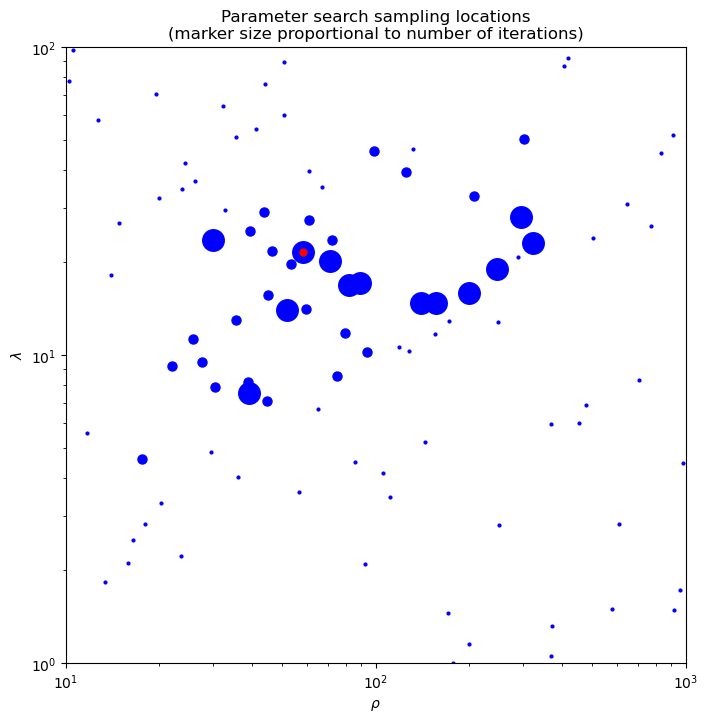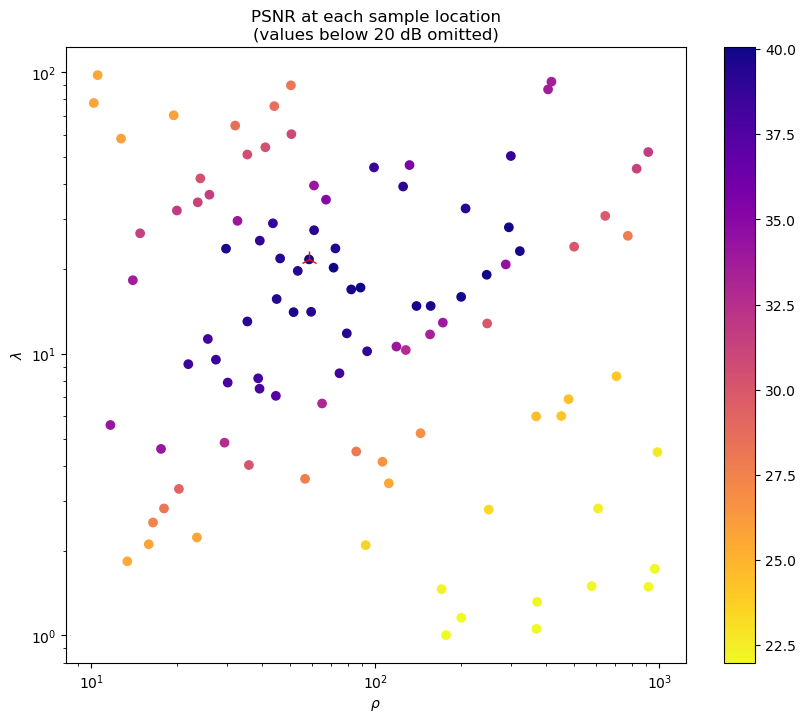Parameter Tuning for TV-Regularized Abel Inversion#
This example demonstrates the use of scico.ray.tune to tune parameters for the companion example script. The ray.tune class API is used in this example.
This script is hard-coded to run on CPU only to avoid the large number of warnings that are emitted when GPU resources are requested but not available, and due to the difficulty of supressing these warnings in a way that does not force use of the CPU only. To enable GPU usage, comment out the os.environ statements near the beginning of the script, and change the value of the “gpu” entry in the resources dict from 0 to 1. Note that two environment variables are set to suppress the
warnings because JAX_PLATFORMS was intended to replace JAX_PLATFORM_NAME but this change has yet to be correctly implemented (see google/jax#6805 and google/jax#10272.
[1]:
# isort: off
import os
os.environ["JAX_PLATFORM_NAME"] = "cpu"
os.environ["JAX_PLATFORMS"] = "cpu"
import numpy as np
import scico.numpy as snp
from scico import functional, linop, loss, metric, plot
from scico.examples import create_circular_phantom
from scico.linop.abel import AbelTransform
from scico.optimize.admm import ADMM, LinearSubproblemSolver
from scico.ray import tune
plot.config_notebook_plotting()
Create a ground truth image.
[2]:
N = 256 # image size
x_gt = create_circular_phantom((N, N), [0.4 * N, 0.2 * N, 0.1 * N], [1, 0, 0.5])
Set up the forward operator and create a test measurement.
[3]:
A = AbelTransform(x_gt.shape)
y = A @ x_gt
np.random.seed(12345)
y = y + np.random.normal(size=y.shape).astype(np.float32)
Compute inverse Abel transform solution for use as initial solution.
[4]:
x_inv = A.inverse(y)
x0 = snp.clip(x_inv, 0.0, 1.0)
Define performance evaluation class.
[5]:
class Trainable(tune.Trainable):
"""Parameter evaluation class."""
def setup(self, config, x_gt, x0, y):
"""This method initializes a new parameter evaluation object. It
is called once when a new parameter evaluation object is created.
The `config` parameter is a dict of specific parameters for
evaluation of a single parameter set (a pair of parameters in
this case). The remaining parameters are objects that are passed
to the evaluation function via the ray object store.
"""
# Get arrays passed by tune call.
self.x_gt, self.x0, self.y = snp.array(x_gt), snp.array(x0), snp.array(y)
# Set up problem to be solved.
self.A = AbelTransform(self.x_gt.shape)
self.f = loss.SquaredL2Loss(y=self.y, A=self.A)
self.C = linop.FiniteDifference(input_shape=self.x_gt.shape)
self.reset_config(config)
def reset_config(self, config):
"""This method is only required when `scico.ray.tune.Tuner` is
initialized with `reuse_actors` set to ``True`` (the default). In
this case, a set of parameter evaluation processes and
corresponding objects are created once (including initialization
via a call to the `setup` method), and this method is called when
switching to evaluation of a different parameter configuration.
If `reuse_actors` is set to ``False``, then a new process and
object are created for each parameter configuration, and this
method is not used.
"""
# Extract solver parameters from config dict.
λ, ρ = config["lambda"], config["rho"]
# Set up parameter-dependent functional.
g = λ * functional.L1Norm()
# Define solver.
cg_tol = 1e-4
cg_maxiter = 25
self.solver = ADMM(
f=self.f,
g_list=[g],
C_list=[self.C],
rho_list=[ρ],
x0=self.x0,
maxiter=10,
subproblem_solver=LinearSubproblemSolver(
cg_kwargs={"tol": cg_tol, "maxiter": cg_maxiter}
),
)
return True
def step(self):
"""This method is called for each step in the evaluation of a
single parameter configuration. The maximum number of times it
can be called is controlled by the `num_iterations` parameter
in the initialization of a `scico.ray.tune.Tuner` object.
"""
# Perform 10 solver steps for every ray.tune step
x_tv = snp.clip(self.solver.solve(), 0.0, 1.0)
return {"psnr": float(metric.psnr(self.x_gt, x_tv))}
Define parameter search space and resources per trial.
[6]:
config = {"lambda": tune.loguniform(1e0, 1e2), "rho": tune.loguniform(1e1, 1e3)}
resources = {"gpu": 0, "cpu": 1} # gpus per trial, cpus per trial
Run parameter search.
[7]:
tuner = tune.Tuner(
tune.with_parameters(Trainable, x_gt=x_gt, x0=x0, y=y),
param_space=config,
resources=resources,
metric="psnr",
mode="max",
num_samples=100, # perform 100 parameter evaluations
num_iterations=10, # perform at most 10 steps for each parameter evaluation
)
results = tuner.fit()
P: 0 R: 0 T: 100 psnr: 4.01e+01 at lambda: 2.16e+01, rho: 5.85e+01
Display best parameters and corresponding performance.
[8]:
best_result = results.get_best_result()
best_config = best_result.config
print(f"Best PSNR: {best_result.metrics['psnr']:.2f} dB")
print("Best config: " + ", ".join([f"{k}: {v:.2e}" for k, v in best_config.items()]))
Best PSNR: 40.06 dB
Best config: lambda: 2.16e+01, rho: 5.85e+01
Plot parameter values visited during parameter search. Marker sizes are proportional to number of iterations run at each parameter pair. The best point in the parameter space is indicated in red.
[9]:
fig = plot.figure(figsize=(8, 8))
trials = results.get_dataframe()
for t in trials.iloc:
n = t["training_iteration"]
plot.plot(
t["config/lambda"],
t["config/rho"],
ptyp="loglog",
lw=0,
ms=(0.5 + 1.5 * n),
marker="o",
mfc="blue",
mec="blue",
fig=fig,
)
plot.plot(
best_config["lambda"],
best_config["rho"],
ptyp="loglog",
title="Parameter search sampling locations\n(marker size proportional to number of iterations)",
xlbl=r"$\rho$",
ylbl=r"$\lambda$",
lw=0,
ms=5.0,
marker="o",
mfc="red",
mec="red",
fig=fig,
)
ax = fig.axes[0]
ax.set_xlim([config["rho"].lower, config["rho"].upper])
ax.set_ylim([config["lambda"].lower, config["lambda"].upper])
fig.show()

Plot parameter values visited during parameter search and corresponding reconstruction PSNRs.The best point in the parameter space is indicated in red.
[10]:
𝜌 = [t["config/rho"] for t in trials.iloc]
𝜆 = [t["config/lambda"] for t in trials.iloc]
psnr = [t["psnr"] for t in trials.iloc]
minpsnr = min(max(psnr), 20.0)
𝜌, 𝜆, psnr = zip(*filter(lambda x: x[2] >= minpsnr, zip(𝜌, 𝜆, psnr)))
fig, ax = plot.subplots(figsize=(10, 8))
sc = ax.scatter(𝜌, 𝜆, c=psnr, cmap=plot.cm.plasma_r)
fig.colorbar(sc)
plot.plot(
best_config["lambda"],
best_config["rho"],
ptyp="loglog",
lw=0,
ms=12.0,
marker="2",
mfc="red",
mec="red",
fig=fig,
ax=ax,
)
ax.set_xscale("log")
ax.set_yscale("log")
ax.set_xlabel(r"$\rho$")
ax.set_ylabel(r"$\lambda$")
ax.set_title("PSNR at each sample location\n(values below 20 dB omitted)")
fig.show()
